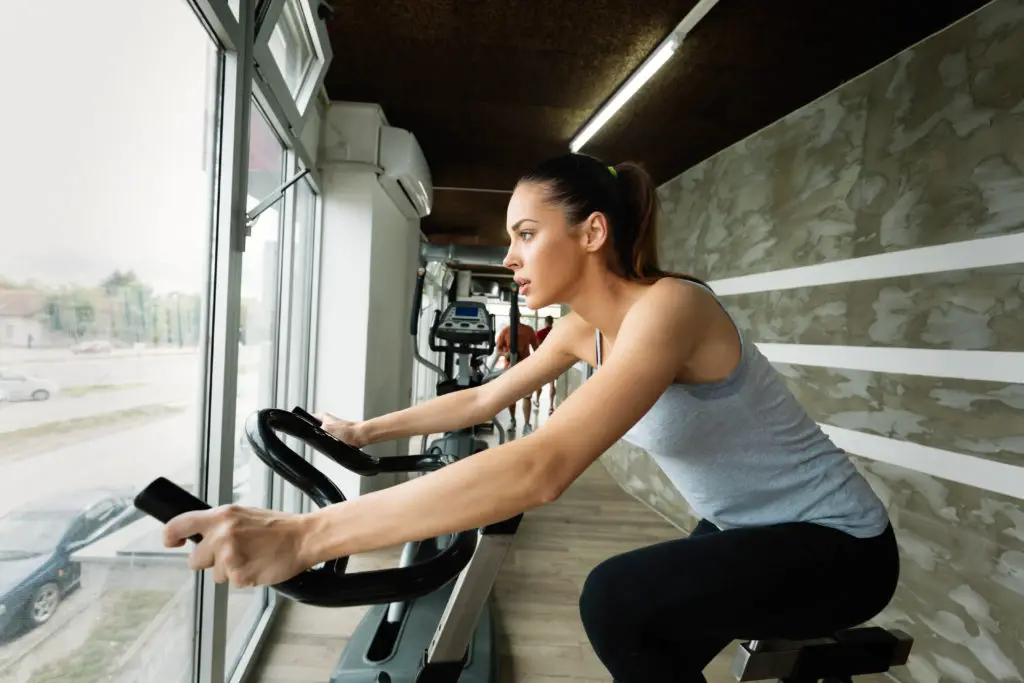
Exercise is vital to health at every stage of life. But years of running, weight training, and other intense workouts can take a toll on your joints. So what is the best way to take care of your overall health without doing damage to your knees? A stationary bike will get you a great workout with minimal risk.
Riding a stationary bike is not bad for your knees. Low-impact aerobic exercise can increase your overall health while alleviating some joint pain. However, incorrect form and preparation can lead to damage over time.
As with most exercise, form is everything! To keep your body healthy and your joints pain-free, we’ve compiled everything you need to know about knee health and cycling.
Page Contents
Cycling is Good for Your Knees

Low impact exercise is good for your overall health and great for the knees. Stationary bikes are often recommended for people who already have knee pain because they do not stress the joints as a treadmill would. Cycling can benefit your knees by:
- Aiding weight control
- Building muscle
- Allowing customizable intensity
Weight Control
Excess weight can lead to increased pressure on joints, particularly the knees. We put stress on our lower body during everyday activities such as walking and going downstairs. The pressure on knees can be up to 4-5 times your body weight when getting low to the ground (think squatting to tie your shoelace).
Being overweight by even 10 lbs can dramatically increase your risk of joint damage in the long term. Additionally, obesity and excess weight are closely associated with inflammation that will contribute to joint trouble.
Aerobic activity like working out on a stationary bike can help you control your weight or lose weight. An hour on a stationary bike can burn up to 600 calories, making it an effective way to increase your caloric deficit.
Building Muscle
Strengthening the muscles supporting your joint is the best way to address knee health. Cycling regularly will build up these muscles over time, protecting your body from daily wear-and-tear.
Cycling is an endurance exercise and will strengthen smaller muscles that are more resistant to fatigue. By strengthening these, you strengthen the whole leg and increase stability. This, in turn, helps to avoid injury.
Customizable Intensity
It is important to start low and slow when it comes to exercising and preventing injury. Especially if you are recovering from knee pain. A stationary bike allows you to control the intensity of your workout and adjust as needed. Most bikes will let you manually adjust resistance, so you can increase the difficulty of your workout as you feel more comfortable.
To start a cycling workout, aim for 30 minutes 3 times a week. Stay consistent for 4-6 weeks before increasing duration and intensity. This will allow your body time to adjust and build good habits.
How Can You Hurt Your Knees on a Stationary Bike?

While a stationary bike is a much better option for your knees than high-impact workouts like running, you should still take steps to protect your body. You can cause injury to your body by:
- Excessively bending your knees
- Using improper form
- Over exerting
- Not warming up
Bending Your Knees
Excessively bending the knees can result in a knee injury. It is recommended that those recovering from knee injury avoid exercises such as squats or leg presses for this exact reason. If the bike seat is too low and forces you to continuously bend your knees past 90°, this could result in injury.
To keep your knees safe, make sure your seat is adjusted properly before starting an intense stationary bike workout. When in doubt, check in with a personal trainer or physical therapist to make sure you are on the right track.
Improper Form
Having improper form can exacerbate any injuries in the knees. When positioning the seat of your stationary bike, make sure that your legs are not completely straight when the pedals are at their lowest point. You should aim for a 5 to 10-degree bend in your legs for optimal form.
Be sure to watch your arms, too. Keep a good grip on the handlebars without locking your elbows. Bring your seat close enough to the front of the bike, so you are not straining to reach the handles.
Over Exerting
One of the most common ways people injure themselves while exercising is over-exertion. Pushing yourself beyond your limit can be taxing on the body. Excessive tiredness can also lead to mistakes in form.
To prevent injuries from over-exertion, increase workout intensity gradually over time. Take breaks when you need them. Get plenty of rest before you hit the gym. Above all, remember to listen to your body. If something hurts, stop doing it. Your joints will thank you later.
Not Warming Up
A great way to avoid injury on the stationary bike is to warm up first. Warm muscles are less likely to be injured, as they are more flexible than cold muscles. Warming up will also help with lubrication. Knees and other joints rely on synovial fluid, a lubricant that allows the bones to move past each other smoothly.
By engaging the muscles and joints in a low-intensity, low-impact warm-up, you prepare both for a more intense workout. Start slow on the bike, and peddle at a moderate pace for 5 minutes or more to get your body loose.
Recumbent Bike Vs. an Upright Bike

When it comes to choosing a stationary bike, there are two main categories: recumbent and upright. These machines differ in how the rider is positioned when sitting on the bike. Both options are a great low-impact workout for the knees but have other pros and cons to be considered.
Recumbent Bikes
These kinds of stationary machines are best for beginners and those with balance problems or back pain. If you already have knee pain or have injured your knee, start here. Having your legs positioned in front, rather than under you, will lessen stress on the joint.
There is also some evidence that novices on recumbent bikes activate their hamstrings more on recumbent bikes than upright ones. Adding strength to leg muscles will help to support the knee joint. However, recumbent bikes typically offer a less strenuous workout than upright.
Upright Bikes
If you’re used to cycling outside then, the upright bike is for you! This type of stationary bicycle most closely mimics the feeling of riding outdoors. Upright bikes are great for full-body workouts, engaging your arms and core, as well as the lower body. This will put more pressure on the hands and wrists, so be careful if you have upper-body injuries.
If you are considering buying a stationary bike for a home gym, upright bikes tend to have a smaller footprint. This makes them great for fitting into small spaces around the house.
Conclusion
Overall, regular exercise on a stationary bike is beneficial to the knees. Cycling offers some risk of injury. However, that risk is outweighed by the multiple health benefits of cycling. By contributing to weight loss, musical strength and providing low-impact cardio activity, exercise on an indoor bike can prevent knee pain and treat injuries to the joint.
When working out on a stationary bike, remember to treat your body with respect. It is not a rental! Listen to your body, exercise regularly, and your knees will be healthy for years to come.
Sources
https://livehealthy.chron.com/can-using-exercise-bike-hurt-knees-4640.html
